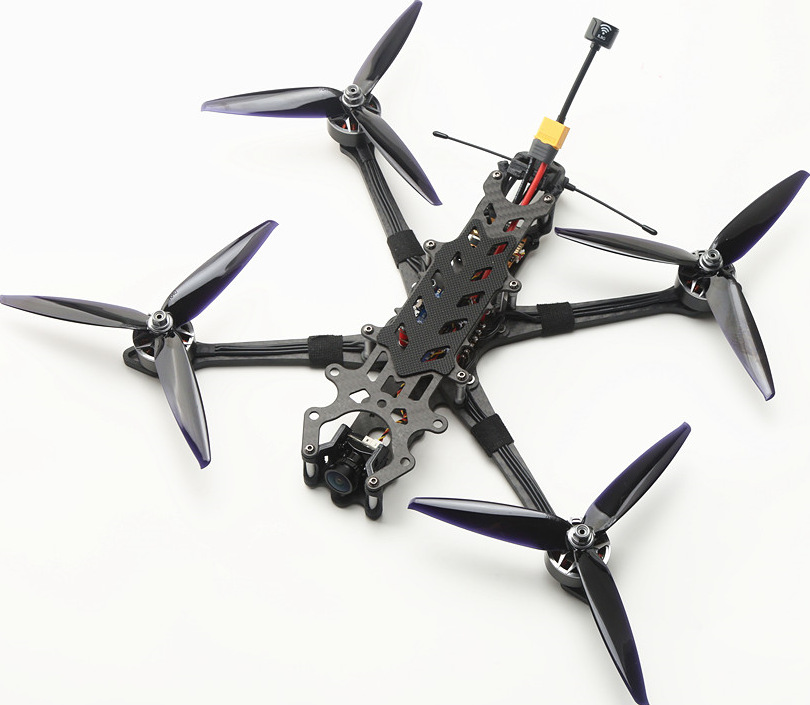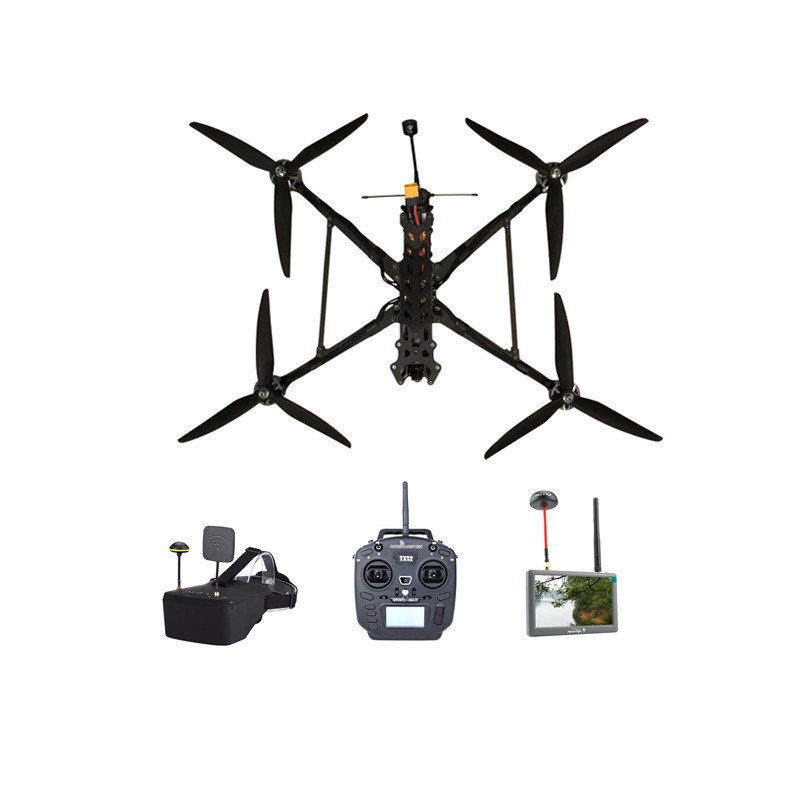A drone, officially known as an Unmanned Aerial Vehicle (UAV), is a type of aircraft operated either by remote control or through autonomous systems. In recent years, drone technology has seen rapid advancements, not only transforming military operations but also finding widespread applications in civilian, commercial, and scientific fields. This article provides a comprehensive analysis of drone technology, its principles, application areas, and future trends, exploring the current state and future development of drones.
I.Definition and Classification of Drones
A drone is an aircraft that is operated via a ground control system or an autonomous flight system. Depending on their flight principles and mission requirements, drones can be categorized into different types:
1.Classification by Flight Platform:
Multirotor Drones: These include quadcopters and hexacopters, which are known for their ease of takeoff, strong stability, and suitability for short-range flights.
Fixed-Wing Drones: These drones offer longer flight times and higher speeds, making them suitable for wide-area, long-distance missions.
Vertical Takeoff and Landing (VTOL) Drones: These combine the benefits of fixed-wing and multirotor drones, capable of vertical takeoff while also offering efficient flight performance.
2.Classification by Application:
Military Drones: Used for reconnaissance, surveillance, and striking enemy targets.
Civilian Drones: Deployed for delivery services, agricultural spraying, disaster monitoring, and more.
Commercial Drones: Utilized in areas such as power line inspection, geographical surveying, and film production.
II. Drone Technology Principles Drone technology primarily involves the flight control system, sensors, power system, and communication system, each playing a critical role in the drone's overall performance.
1.Flight Control System: The "brain" of the drone, it regulates flight attitude and trajectory through sensor data and control algorithms. Modern drones are typically equipped with GPS navigation, Inertial Measurement Units (IMUs), and other critical components to ensure precise and stable flight.
2.Power System: This determines the drone's endurance and flight performance. While traditional drones mostly rely on battery power, newer power systems such as hydrogen fuel cells and solar cells are gradually entering the market.
3.Communication System: Essential for the communication between the drone and the ground control station, this system dictates the drone's remote control and data transmission capabilities. Modern drones often utilize digital communication technologies, supporting high-definition image and video transmission.
4.Sensors: By equipping various sensors, such as cameras, LiDAR, and thermal imaging devices, drones can perceive their surroundings and execute complex tasks accordingly.
III. Applications of Drones
1.Military Field: Drones were first widely used in the military domain. For example, the U.S. Predator drone is capable of long-duration reconnaissance missions and can also be equipped with weapons for precision strikes. In recent years, drones have played an increasingly vital role in warfare, particularly in counterterrorism operations and unmanned warfare.
Case Study: Drone Operations in the 2020 Nagorno-Karabakh Conflict During the 2020 Nagorno-Karabakh conflict, the Azerbaijani military extensively used Turkish-made TB2 drones to conduct precision strikes against Armenian forces. These drones could loiter for extended periods, transmit real-time battlefield images, and be remotely controlled to fire weapons, significantly altering the battlefield dynamics.
2.Logistics and Delivery: The quick response and flexibility of drones have made them a focal point in the logistics and delivery industries. Amazon's "Prime Air" project plans to use drones to provide delivery services within 30 minutes. Drones are also playing a crucial role in logistics delivery and emergency supply drops in remote areas.
Case Study: SF Express Drone Delivery in China SF Express conducted drone logistics tests in remote mountainous areas, using drones for delivery, significantly improving delivery efficiency and reducing labor costs. Particularly in regions with complex terrain and difficult access, drones have demonstrated immense potential.
3.Agriculture: The introduction of drone technology has profoundly transformed agricultural practices. Drones can accurately monitor farmland conditions, perform tasks such as fertilization and pesticide spraying, helping farmers optimize resource allocation and improve productivity.
Case Study: DJI Agricultural Drones DJI has launched specialized agricultural drones, which can identify crop health conditions through sensors and precisely spray pesticides, effectively reducing chemical use, minimizing environmental pollution, and significantly enhancing agricultural productivity.
4.Disaster Relief and Emergency Response: Drones have unique advantages in disaster relief operations. They can quickly reach disaster-stricken areas in harsh environments to assess damage and conduct search and rescue missions. For example, during earthquakes, floods, and other natural disasters, drones can provide real-time monitoring, offering critical data support for rescue efforts.
Case Study: Drone Applications in the Fukushima Nuclear Disaster in Japan After the 2011 Fukushima nuclear disaster, radiation levels in many areas prevented human access. Drones were widely used for radiation monitoring and disaster assessment around the nuclear power plant, becoming an essential tool in post-disaster emergency response.
5.Surveying and Environmental Monitoring: Equipped with high-precision cameras and sensors, drones can quickly scan and collect data over large areas, widely used in geographical surveying, forest fire monitoring, pollution monitoring, and other fields.
IV. Challenges in Drone Development
1.Regulations and Policies: The rapid development of drones has complicated regulatory efforts. Ensuring that drones operate in public spaces without compromising public safety and privacy is a significant concern. Governments worldwide are developing and refining regulations to manage drone usage.
Case Study: U.S. FAA Regulations on Drones The U.S. Federal Aviation Administration (FAA) has implemented a series of regulations governing commercial drones, requiring that drones remain within the operator's line of sight during flight and obtain flight permits. These measures have effectively reduced the potential threats drones pose to civil aviation routes.
2.Technical Bottlenecks: Despite significant advances in drone technology, numerous challenges remain. For instance, battery endurance limits drone flight time, and signal interference can lead to drone control issues. Additionally, improving drones' autonomous flight and obstacle avoidance capabilities remains a key focus for future technological development.
3.Security and Privacy Concerns: The widespread use of drones has raised concerns about privacy and security. Unauthorized drone flights could infringe on personal privacy or even be used for illegal activities. Addressing these issues requires balancing technological advancement with privacy protection.
V. Future Trends in Drone Development
1.Autonomous Flight and Intelligence: As artificial intelligence and machine learning technologies advance, drones' autonomous flight capabilities will significantly improve. In the future, drones will be able to autonomously complete tasks in complex environments, such as obstacle avoidance and target recognition, thereby enhancing mission efficiency and safety.
2.Integration of 5G and Drones: The high speed and low latency of 5G technology provide new opportunities for drone communication. With 5G networks, drones can achieve real-time HD image transmission, better handling remote operations and data processing needs.
3.Collaborative Drone Operations: Collaborative drone operations will be an important development direction in the military field. Through networked control systems, multiple drones can cooperate in the same mission, achieving more efficient combat outcomes.
As an emerging technology, drones are transforming various aspects of the world. From military operations to logistics delivery, from agricultural production to disaster relief, drones exhibit tremendous potential for application. In the future, as technology continues to advance, drones will play an increasingly important role in more fields, driving societal development and progress. However, drone development also faces numerous challenges, and striking a balance between technological innovation and safety regulation will be key to future progress.
By exploring drone technology, applications, and future trends, we can foresee that drones will play a crucial role in the ongoing process of globalization, becoming an important driving force for economic and social advancement.

